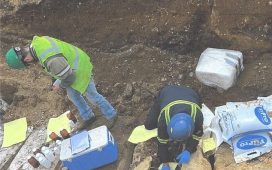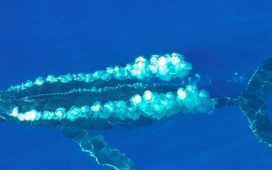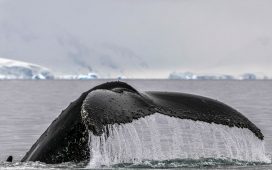
A new DNA study of the tequila bat could help conservationists protect both the flying mammal and the alcoholic drink.
The lesser long-nosed bat, Leptonycteris yerbabuenae, plays a crucial role in pollinating the blue agave plant used to produce the Mexican spirit
However the growth in the tequila industry over the last decade has resulted in growers using cloned plants which are cut down before they flower, rather than allowing them to reproduce naturally.
This results not only in less genetically diverse plants more susceptible to disease but also in lower numbers of bats. One species, the greater long-nosed bat, is on the IUCN Red List of endangered species.
Farmers are now being encouraged to allow bats to pollinate part of their agave crop in return for certification of their tequila as ”bat friendly”.
1/20 Pluto has ‘beating heart’ of frozen nitrogen
Pluto has a ‘beating heart’ of frozen nitrogen that is doing strange things to its surface, Nasa has found.
The mysterious core seems to be the cause of features on its surface that have fascinated scientists since they were spotted by Nasa’s New Horizons mission.
“Before New Horizons, everyone thought Pluto was going to be a netball – completely flat, almost no diversity,” said Tanguy Bertrand, an astrophysicist and planetary scientist at NASA’s Ames Research Center and the lead author on the new study.
“But it’s completely different. It has a lot of different landscapes and we are trying to understand what’s going on there.”
Getty
2/20 Over 400 species discovered this year by Natural History Museum
The ancient invertabrate worm-like species rhenopyrgus viviani (pictured) is one of over 400 species previously unknown to science that were discovered by experts at the Natural History Museum this year
PA
3/20 Jackdaws can identify ‘dangerous’ humans
Jackdaws can identify “dangerous” humans from listening to each other’s warning calls, scientists say.
The highly social birds will also remember that person if they come near their nests again, according to researchers from the University of Exeter.
In the study, a person unknown to the wild jackdaws approached their nest. At the same time scientists played a recording of a warning call (threatening) or “contact calls” (non-threatening). The next time jackdaws saw this same person, the birds that had previously heard the warning call were defensive and returned to their nests more than twice as quickly on average.
Getty
4/20 Turtle embryos influence sex by shaking
The sex of the turtle is determined by the temperatures at which they are incubated. Warm temperatures favour females.
But by wiggling around the egg, embryos can find the “Goldilocks Zone” which means they are able to shield themselves against extreme thermal conditions and produce a balanced sex ratio, according to the new study published in Current Biology journal
Ye et al/Current Biology
5/20 Elephant poaching rates drop in Africa
African elephant poaching rates have dropped by 60 per cent in six years, an international study has found.
It is thought the decline could be associated with the ivory trade ban introduced in China in 2017.
Reuters
6/20 Ancient four-legged whale discovered in Peru
Scientists have identified a four-legged creature with webbed feet to be an ancestor of the whale. Fossils unearthed in Peru have led scientists to conclude that the enormous creatures that traverse the planet’s oceans today are descended from small hoofed ancestors that lived in south Asia 50 million years ago
A. Gennari
7/20 Animal with transient anus discovered
A scientist has stumbled upon a creature with a “transient anus” that appears only when it is needed, before vanishing completely. Dr Sidney Tamm of the Marine Biological Laboratory could not initially find any trace of an anus on the species. However, as the animal gets full, a pore opens up to dispose of waste
Steven G Johnson
8/20 Giant bee spotted
Feared extinct, the Wallace’s Giant bee has been spotted for the first time in nearly 40 years. An international team of conservationists spotted the bee, that is four times the size of a typical honeybee, on an expedition to a group of Indonesian Islands
Clay Bolt
9/20 New mammal species found inside crocodile
Fossilised bones digested by crocodiles have revealed the existence of three new mammal species that roamed the Cayman Islands 300 years ago. The bones belonged to two large rodent species and a small shrew-like animal
New Mexico Museum of Natural History
10/20 Fabric that changes according to temperature created
Scientists at the University of Maryland have created a fabric that adapts to heat, expanding to allow more heat to escape the body when warm and compacting to retain more heat when cold
Faye Levine, University of Maryland
11/20 Baby mice tears could be used in pest control
A study from the University of Tokyo has found that the tears of baby mice cause female mice to be less interested in the sexual advances of males
Getty
12/20 Final warning to limit “climate catastrophe”
The Intergovernmental Panel on Climate Change has issued a report which projects the impact of a rise in global temperatures of 1.5 degrees Celsius and warns against a higher increase
Getty
13/20 Nobel prize for evolution chemists
The nobel prize for chemistry has been awarded to three chemists working with evolution. Frances Smith is being awarded the prize for her work on directing the evolution of enzymes, while Gregory Winter and George Smith take the prize for their work on phage display of peptides and antibodies
Getty/AFP
14/20 Nobel prize for laser physicists
The nobel prize for physics has been awarded to three physicists working with lasers. Arthur Ashkin (L) was awarded for his “optical tweezers” which use lasers to grab particles, atoms, viruses and other living cells. Donna Strickland and Gérard Mourou were jointly awarded the prize for developing chirped-pulse amplification of lasers
Reuters/AP
15/20 Discovery of a new species of dinosaur
The Ledumahadi Mafube roamed around 200 million years ago in what is now South Africa. Recently discovered by a team of international scientists, it was the largest land animal of its time, weighing 12 tons and standing at 13 feet. In Sesotho, the South African language of the region in which the dinosaur was discovered, its name means “a giant thunderclap at dawn”
Viktor Radermacher / SWNS
16/20 Birth of a planet
Scientists have witnessed the birth of a planet for the first time ever.
This spectacular image from the SPHERE instrument on ESO’s Very Large Telescope is the first clear image of a planet caught in the very act of formation around the dwarf star PDS 70. The planet stands clearly out, visible as a bright point to the right of the center of the image, which is blacked out by the coronagraph mask used to block the blinding light of the central star.
ESO/A. Müller et al
17/20 New human organ discovered that was previously missed by scientists
Layers long thought to be dense, connective tissue are actually a series of fluid-filled compartments researchers have termed the “interstitium”.
These compartments are found beneath the skin, as well as lining the gut, lungs, blood vessels and muscles, and join together to form a network supported by a mesh of strong, flexible proteins
Getty
18/20 Previously unknown society lived in Amazon rainforest before Europeans arrived, say archaeologists
Working in the Brazilian state of Mato Grosso, a team led by archaeologists at the University of Exeter unearthed hundreds of villages hidden in the depths of the rainforest.
These excavations included evidence of fortifications and mysterious earthworks called geoglyphs
José Iriarte
19/20 One in 10 people have traces of cocaine or heroin on fingerprints, study finds
More than one in 10 people were found to have traces of class A drugs on their fingers by scientists developing a new fingerprint-based drug test.
Using sensitive analysis of the chemical composition of sweat, researchers were able to tell the difference between those who had been directly exposed to heroin and cocaine, and those who had encountered it indirectly.
Getty
20/20 Nasa releases stunning images of Jupiter’s great red spot
The storm bigger than the Earth, has been swhirling for 350 years. The image’s colours have been enhanced after it was sent back to Earth.
Pictures by: Tom Momary
1/20 Pluto has ‘beating heart’ of frozen nitrogen
Pluto has a ‘beating heart’ of frozen nitrogen that is doing strange things to its surface, Nasa has found.
The mysterious core seems to be the cause of features on its surface that have fascinated scientists since they were spotted by Nasa’s New Horizons mission.
“Before New Horizons, everyone thought Pluto was going to be a netball – completely flat, almost no diversity,” said Tanguy Bertrand, an astrophysicist and planetary scientist at NASA’s Ames Research Center and the lead author on the new study.
“But it’s completely different. It has a lot of different landscapes and we are trying to understand what’s going on there.”
Getty
2/20 Over 400 species discovered this year by Natural History Museum
The ancient invertabrate worm-like species rhenopyrgus viviani (pictured) is one of over 400 species previously unknown to science that were discovered by experts at the Natural History Museum this year
PA
3/20 Jackdaws can identify ‘dangerous’ humans
Jackdaws can identify “dangerous” humans from listening to each other’s warning calls, scientists say.
The highly social birds will also remember that person if they come near their nests again, according to researchers from the University of Exeter.
In the study, a person unknown to the wild jackdaws approached their nest. At the same time scientists played a recording of a warning call (threatening) or “contact calls” (non-threatening). The next time jackdaws saw this same person, the birds that had previously heard the warning call were defensive and returned to their nests more than twice as quickly on average.
Getty
4/20 Turtle embryos influence sex by shaking
The sex of the turtle is determined by the temperatures at which they are incubated. Warm temperatures favour females.
But by wiggling around the egg, embryos can find the “Goldilocks Zone” which means they are able to shield themselves against extreme thermal conditions and produce a balanced sex ratio, according to the new study published in Current Biology journal
Ye et al/Current Biology
5/20 Elephant poaching rates drop in Africa
African elephant poaching rates have dropped by 60 per cent in six years, an international study has found.
It is thought the decline could be associated with the ivory trade ban introduced in China in 2017.
Reuters
6/20 Ancient four-legged whale discovered in Peru
Scientists have identified a four-legged creature with webbed feet to be an ancestor of the whale. Fossils unearthed in Peru have led scientists to conclude that the enormous creatures that traverse the planet’s oceans today are descended from small hoofed ancestors that lived in south Asia 50 million years ago
A. Gennari
7/20 Animal with transient anus discovered
A scientist has stumbled upon a creature with a “transient anus” that appears only when it is needed, before vanishing completely. Dr Sidney Tamm of the Marine Biological Laboratory could not initially find any trace of an anus on the species. However, as the animal gets full, a pore opens up to dispose of waste
Steven G Johnson
8/20 Giant bee spotted
Feared extinct, the Wallace’s Giant bee has been spotted for the first time in nearly 40 years. An international team of conservationists spotted the bee, that is four times the size of a typical honeybee, on an expedition to a group of Indonesian Islands
Clay Bolt
9/20 New mammal species found inside crocodile
Fossilised bones digested by crocodiles have revealed the existence of three new mammal species that roamed the Cayman Islands 300 years ago. The bones belonged to two large rodent species and a small shrew-like animal
New Mexico Museum of Natural History
10/20 Fabric that changes according to temperature created
Scientists at the University of Maryland have created a fabric that adapts to heat, expanding to allow more heat to escape the body when warm and compacting to retain more heat when cold
Faye Levine, University of Maryland
11/20 Baby mice tears could be used in pest control
A study from the University of Tokyo has found that the tears of baby mice cause female mice to be less interested in the sexual advances of males
Getty
12/20 Final warning to limit “climate catastrophe”
The Intergovernmental Panel on Climate Change has issued a report which projects the impact of a rise in global temperatures of 1.5 degrees Celsius and warns against a higher increase
Getty
13/20 Nobel prize for evolution chemists
The nobel prize for chemistry has been awarded to three chemists working with evolution. Frances Smith is being awarded the prize for her work on directing the evolution of enzymes, while Gregory Winter and George Smith take the prize for their work on phage display of peptides and antibodies
Getty/AFP
14/20 Nobel prize for laser physicists
The nobel prize for physics has been awarded to three physicists working with lasers. Arthur Ashkin (L) was awarded for his “optical tweezers” which use lasers to grab particles, atoms, viruses and other living cells. Donna Strickland and Gérard Mourou were jointly awarded the prize for developing chirped-pulse amplification of lasers
Reuters/AP
15/20 Discovery of a new species of dinosaur
The Ledumahadi Mafube roamed around 200 million years ago in what is now South Africa. Recently discovered by a team of international scientists, it was the largest land animal of its time, weighing 12 tons and standing at 13 feet. In Sesotho, the South African language of the region in which the dinosaur was discovered, its name means “a giant thunderclap at dawn”
Viktor Radermacher / SWNS
16/20 Birth of a planet
Scientists have witnessed the birth of a planet for the first time ever.
This spectacular image from the SPHERE instrument on ESO’s Very Large Telescope is the first clear image of a planet caught in the very act of formation around the dwarf star PDS 70. The planet stands clearly out, visible as a bright point to the right of the center of the image, which is blacked out by the coronagraph mask used to block the blinding light of the central star.
ESO/A. Müller et al
17/20 New human organ discovered that was previously missed by scientists
Layers long thought to be dense, connective tissue are actually a series of fluid-filled compartments researchers have termed the “interstitium”.
These compartments are found beneath the skin, as well as lining the gut, lungs, blood vessels and muscles, and join together to form a network supported by a mesh of strong, flexible proteins
Getty
18/20 Previously unknown society lived in Amazon rainforest before Europeans arrived, say archaeologists
Working in the Brazilian state of Mato Grosso, a team led by archaeologists at the University of Exeter unearthed hundreds of villages hidden in the depths of the rainforest.
These excavations included evidence of fortifications and mysterious earthworks called geoglyphs
José Iriarte
19/20 One in 10 people have traces of cocaine or heroin on fingerprints, study finds
More than one in 10 people were found to have traces of class A drugs on their fingers by scientists developing a new fingerprint-based drug test.
Using sensitive analysis of the chemical composition of sweat, researchers were able to tell the difference between those who had been directly exposed to heroin and cocaine, and those who had encountered it indirectly.
Getty
20/20 Nasa releases stunning images of Jupiter’s great red spot
The storm bigger than the Earth, has been swhirling for 350 years. The image’s colours have been enhanced after it was sent back to Earth.
Pictures by: Tom Momary
“Tequila bats are beautiful, especially after they arrive back from feeding as they return covered in pollen, completely yellow, a sign of how important they are to this ecosystem,” said bat expert Dr Angelica Menchaca, who led the study at the University of Bristol.
The researchers took skin samples from two different populations of bats to try and understand how best to protect them from habitat loss and other threats.
After travelling to remote caves in Mexico, they would wait for the bats to go out to forage for food at around midnight.
“We would then enter the caves that were filled with thousands of baby bats, all packed together in nurseries, waiting for their mums to return,” said Dr Menchaca.
“Our aim was to collect DNA skin samples from the bat’s wing which heals quickly and doesn’t harm them.”
The team then analysed the samples’ mitochondrial DNA to identify two distinct maternal lines – one which migrates to the Sonoran Desert in the spring months to give birth and pollinate a variety of plants, and another which inhabits southern Mexico all year-round, forming large breeding colonies in the winter months.
Dr Menchaca, who published the study in the scientific journal Global Ecology and Conservation, explained: “Contrary to current practice, our study demonstrates that the species must be managed as two conservation units in Mexico.
“We have shown that tequila bat populations that establish maternity colonies in the Sonoran Desert in northern Mexico show a distinct migratory behaviour, breed during the summer, have specific habitat requirements and belong to a maternal line distinct to their southern counterparts.
“In the present context of an accelerated rate of habitat loss, increased fear of bats and decreased appreciation as ecosystem service providers, understanding how we can help support this important species survive these threats is even more relevant.
“We are studying other differences related to their behaviour and morphology that will also help us understand how these bats adapt to diverse habitats.”
Additional reporting by Press Association














